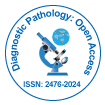Cardiovascular Implications of Coronavirus and Other Respiratory Viruses
Received: 13-Aug-2021 / Accepted Date: 27-Aug-2021 / Published Date: 03-Sep-2021 DOI: 10.4172/2476-2024.s5.1000018
Study Description
In severe diseases, such as COVID-19, failure of the multi-organ system can lead to death or even cause severe acute respiratory syndrome. The most severe clinical symptom of this disorder is the presence of several circulating cytokines. The severity of COVID-19 depends on the level of cytokines in the body. In most cases, these can lead to multi-organ damage, such as the heart and the circulatory system failure. The SARS-CoV-2 protein is known to decrease the levels of angiotensin II in the body. This process can result in increased sympathetic activity and pulmonary vascular permeability. One of the biggest risks factors for severe COVID-19 is the presence of other ailments, such as diabetes and heart disease. In China, for instance, out of almost 50,000 patients, the highest mortality rate was observed among those with heart disease. COVID-19 affects the majority of heart disease patients over the age of 65. In addition, many other patients with the same conditions, such as diabetes and high blood pressure are at high risk of suffering.
The causes of mortality in patients with COVID-19 can be attributed to various factors. One of these includes elevated troponin levels. This level is known to predict severe disease and mortality in patients with COVID-19. Individuals with pre-existing conditions such as heart failure are at an increased risk for severe disease and mortality due to COVID-19. This drug may also cause new cardiovascular implications in patients without known heart diseases. It is believed that these conditions are linked to the increased levels of COVID-19 in healthy young individuals, which may be triggered by the SARS-CoV-2 infections or systemic damage caused by cytokine storms. Many people with COVID-19 experience arrhythmias that are caused by metabolic abnormalities. These conditions can be treated by monitoring serum levels of various cytokines and measuring cardiac arrhythmias. The management of these conditions can help minimize the risk of severe COVID19 complications. Some of these include atrial fibrillation, heart failure, and stroke.
Compared to flu, SARS-CoV-2 features a highest death rate additionally to a better prevalence of complications in SARS-CoV-2 compared to flu, especially in patients with pre-existing disorder. However, testing for seasonal flu and reporting to health authorities is completed during a limited way compared to COVID-19 and different health authorities have alternative ways of reporting death from both diseases. Despite the fact that many countries have used these statistical parameters to match between coronavirus and flu. In China, official statistics place SARS-CoV-2 to possess almost 15 times higher CMR compared to flu. Furthermore, deaths in patients with cardiac abnormalities/ cardiovascular illnesses and COVID-19 have a much higher level of comorbidity compared to the flu. It's important to notice that cardiac diseases predispose more severe disease and risk of death (primarily from myocarditis) in both flu and COVID-19, but the rates are higher in coronavirus disease compared to flu.
Citation: Li QK ( 2021) Cardiocascular Implications of Coronavirus and Other R espiratory V iruses. Diagnos Pathol Open S5: 018. DOI: 10.4172/2476-2024.s5.1000018
Copyright: © 2021 Li QK. This is an open-access article distributed under the terms of the Creative Commons Attribution License, which permits unrestricted use, distribution, and reproduction in any medium, provided the original author and source are credited.
Select your language of interest to view the total content in your interested language
Share This Article
Open Access Journals
Article Tools
Article Usage
- Total views: 1886
- [From(publication date): 0-2021 - Dec 09, 2025]
- Breakdown by view type
- HTML page views: 1197
- PDF downloads: 689
